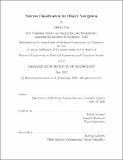| dc.contributor.advisor | Agrawal, Pulkit | |
| dc.contributor.author | Yue, Albert | |
| dc.date.accessioned | 2022-08-29T16:30:07Z | |
| dc.date.available | 2022-08-29T16:30:07Z | |
| dc.date.issued | 2022-05 | |
| dc.date.submitted | 2022-05-27T16:18:37.516Z | |
| dc.identifier.uri | https://hdl.handle.net/1721.1/145058 | |
| dc.description.abstract | Object navigation is the embodied task of navigating to an instance of a specified object in unseen environments. Previous work has made impressive progress on the problem, but there remains much room for improvement with current state-of-the-art methods reaching a success rate of less than one in three. In this work, we evaluate a state-of-the-art approach, identifying false positives in object detection as the main point of failure. We propose introducing a new module to verify success when the agent attempts to stop. We introduce a learning-based classifier that learns and compares embeddings for visual observations and object categories and find that it works well at predicting success, outperforming both naive baselines and a heuristic-based classifier. We also find no improvement when using a ensemble model for semantic segmentation, although we believe there is more to be tested before arriving at a conclusive judgement. | |
| dc.publisher | Massachusetts Institute of Technology | |
| dc.rights | In Copyright - Educational Use Permitted | |
| dc.rights | Copyright MIT | |
| dc.rights.uri | http://rightsstatements.org/page/InC-EDU/1.0/ | |
| dc.title | Success Classification for Object Navigation | |
| dc.type | Thesis | |
| dc.description.degree | M.Eng. | |
| dc.contributor.department | Massachusetts Institute of Technology. Department of Electrical Engineering and Computer Science | |
| mit.thesis.degree | Master | |
| thesis.degree.name | Master of Engineering in Electrical Engineering and Computer Science | |
